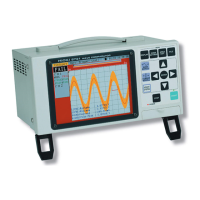247
_____________________________________________________________________________________________
13.2 Reference
______________________________________________________________________________________________
1
2
3
4
5
6
7
8
9
10
11
12
13
14
15
13.2.1 Sampling
Sampling period T
Mea
sure
ment
Mea
sure
ment
Time
13.2.2 Aliasing
Sampling period
Actual input signal
Observed waveform
Aliasing occurs because sampling period
is longer than input signal period
13.2 Reference
The 8730-10, 8731-10 converts the input signal to a digital value, then
carries out all internal processing digitally. This process of converting an
analog signal to digital values is termed sampling.
Sampling measures the magnitude of the signal at fixed time intervals
(sampling periods).
The rate of taking these measurements is termed the sampling rate.
The units are S/s, read as samples per second.
This is the reciprocal of the sampling period (1/T).
If the frequency of the signal being measured is significantly higher than
the sampling rate, it is possible for sampling to produce an apparent signal
which is actually nonexistent. This phenomenon is termed aliasing.
The measurement frequency limit is determined by the setting of the time
axis range. In any event, it is always best to use the highest practicable
sampling rate.
The measurement frequency limit is determined by the time axis range,
which is to be set. Use the highest practicable speed range whenever
possible.

